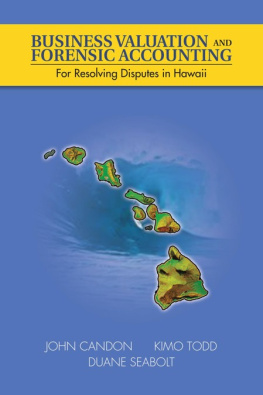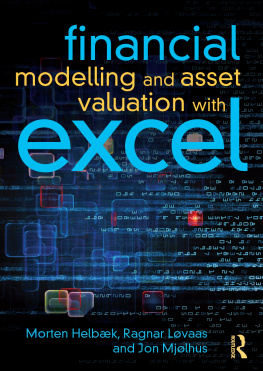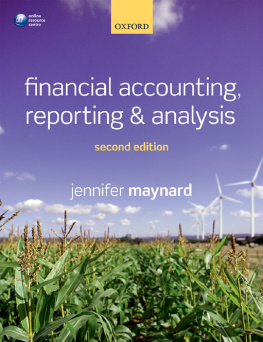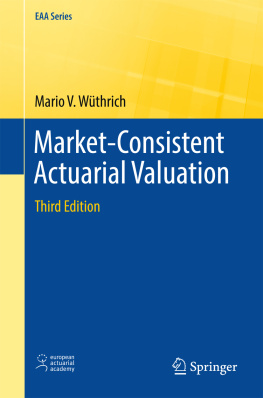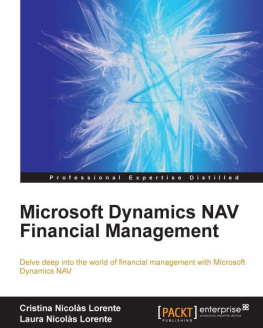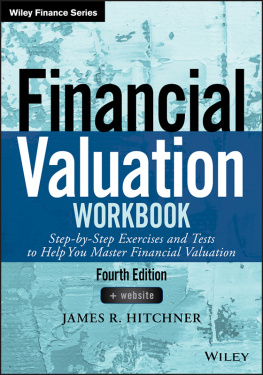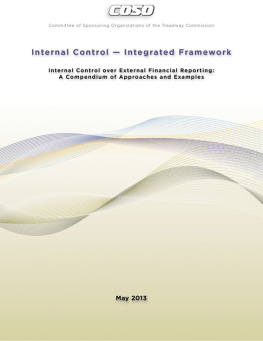Copyright 2011 by Michael J. Mard, James R. Hitchner, Steven D. Hyden. All rights reserved.
Published by John Wiley & Sons, Inc., Hoboken, New Jersey.
Published simultaneously in Canada.
No part of this publication may be reproduced, stored in a retrieval system, or transmitted in any form or by any means, electronic, mechanical, photocopying, recording, scanning, or otherwise, except as permitted under Section 107 or 108 of the 1976 United States Copyright Act, without either the prior written permission of the Publisher, or authorization through payment of the appropriate per-copy fee to the Copyright Clearance Center, Inc., 222 Rosewood Drive, Danvers, MA 01923, (978) 750-8400, fax (978) 646-8600, or on the Web at www.copyright.com . Requests to the Publisher for permission should be addressed to the Permissions Department, John Wiley & Sons, Inc., 111 River Street, Hoboken, NJ 07030, (201) 748-6011, fax (201) 748-6008, or online at http://www.wiley.com/go/permissions .
Limit of Liability/Disclaimer of Warranty: While the publisher and author have used their best efforts in preparing this book, they make no representations or warranties with respect to the accuracy or completeness of the contents of this book and specifically disclaim any implied warranties of merchantability or fitness for a particular purpose. No warranty may be created or extended by sales representatives or written sales materials. The advice and strategies contained herein may not be suitable for your situation. You should consult with a professional where appropriate. Neither the publisher nor author shall be liable for any loss of profit or any other commercial damages, including but not limited to special, incidental, consequential, or other damages. For general information on our other products and services or for technical support, please contact our Customer Care Department within the United States at (800) 762-2974, outside the United States at (317) 572-3993 or fax (317) 572-4002.
Wiley also publishes its books in a variety of electronic formats. Some content that appears in print may not be available in electronic books. For more information about Wiley products, visit our web site at www.wiley.com .
Library of Congress Cataloging-in-Publication Data
Mard, Michael J.
Valuation for financial reporting : fair value, business combinations, intangible assets, goodwill and impairment analysis / Michael J. Mard, James R. Hitchner, Steven D.
Hyden. 3rd ed.
p. cm.
Includes bibliographical references and index.
ISBN 978-0-470-53489-2 (cloth); ISBN 978-0-470-93335-0 (ebk);
ISBN 978-0-470-93341-1 (ebk); ISBN 978-0-470-93342-8 (ebk)
1. Intangible propertyAccounting. 2. Goodwill (Commerce)Accounting.
I. Hitchner, James R. II. Hyden, Steven D. III. Title.
HF5681.I55V348 2011
657.3dc22
2010026661
To our families, near and far, young and old,
those that have come to us recently
and those that have gone before us:
we love you and thank you.
To Pam, Seph, Joe, Shelley, and
Isabelle (coming this Thanksgiving),
Mom and Greg:
Thank you for your love and support,
which make this book possible.
Mike Mard
To my three children,
Jason, Michael, and Deborah.
I couldn't be more proud of you.
To Karen, with love,
you make all we do so much better.
Jim Hitchner
To my loves, Maria and Amy:
Your support means everything.
Steve Hyden
Preface
The third edition of this book furthers the elements of fair value in financial reporting in accordance with recent standards, with primary emphasis on fair value measurements and reporting, and the valuation and impairment analysis of intangible assets and goodwill. Chapter 1 discusses the objectives of financial reporting and the adoption of the Financial Accounting Standards Board's (FASB) Accounting Standards Codification (ASC), including Fair Value Measurements, from the perspective of the valuation specialist. In addition, Chapter 1 describes work done by academic researchers on the relevance of fair value accounting.
This book is designed to provide practical implementation guidance to CFOs, auditors, and other CPAs in the private and public sectors. Because of the requirements for financial reporting of intangible assets and goodwill, auditors and valuation analysts will not only have to focus on determining the fair values of assets in accordance with Topics 350 and 820 of the ASC, they also must assess on at least an annual basis whether impairment of those assets has occurred. This book explains the valuation aspects of the new financial reporting requirements, including how to identify and measure contingent consideration, consideration transferred, goodwill, and identifiable intangible assets for both controlling and noncontrolling interests. It shows how to determine if impairment has occurred and employs specific methods to assess the financial impact of such impairment.
In later chapters, readers are provided an example of a business combination in which tangible and intangible assets are identified and value measured. A detailed example of an impairment analysis is also provided. These case studies cover the determination of fair value of assets and reporting units under ASC Topics 350 and 805, which incorporate FASB's Fair Value Measurement requirements.
Significant issues related to impairment testing are addressed, including treatment of previously identified but unbooked intangible assets subsumed in goodwill, what constitutes a reporting unit, and how to handle synergies resulting from the business combination and subsequent impairment.
We have included a checklist for data gathering and a flowchart and work program designed to guide the valuation analyst through the maze of methodologies that may be employed in the determination of the value of intangibles. To assist with the financial reporting standards, we have included a flowchart and worksheet for the fair value measurement process. In-process research and development (IPR&D) receives special attention, with the inclusion of the American Institute of Certified Public Accountants (AICPA) Model Audit Program, which delineates procedures to be considered when auditing a business combination transaction that may include the purchase of IPR&D.
This book covers in broad terms the financial reporting disclosures required by generally accepted accounting principles (GAAP). We believe such matters to be corporate and audit decisions. Our goal has been to provide a concise and understandable explanation of the regulatory and conceptual issues underlying fair value measurements in business combinations and impairment testing. We would like to address attention to the fact that the AICPA Practice Aid Assets Acquired in a Business Combination to Be Used in Research and Development Activities: A Focus on Software, Electronic Devices, and Pharmaceutical Industries is no longer in print but is being revised by the AICPA. However, at this writing the revision has not been completed. The elements we cite from the original document are, we believe, fundamentally and economically sound. We believe that citing the original document accurately enhances fair value measurement and allows us to bring this text to market in a more timely fashion. The authors hope that this third edition will provide practical implementation guidance for the preparer, as well as a useful framework for interpretation by the user.
Acknowledgments
To Deanna Muraki, special thanks for your hard work, constructive editing, and for keeping us focused on the finish line. This book was made possible with your service as in-house editor and processor. We also thank John DeRemigis, editor, Judy Howarth, associate editor, and Chris Gage, production editor, for providing John Wiley & Sons formidable support. We particularly thank John Wiley & Sons and Edward Trott (retired FASB) for allowing us to utilize material from Business Combination with SFAS 141R, 157, and 160, A Guide to Financial Reporting , from which much was drawn for this text. Thank you to Donald Wisehart for his contribution in the reporting standards comparison in Chapter 6. Our staff deserves special thanks for keeping the wheels turning while we were elsewhere engaged.



